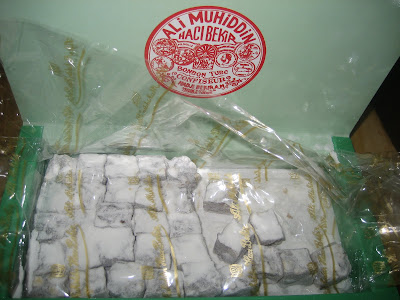One striking feature of the festival was its inclusion of models of parts of several major cities, including Istanbul. Wandering through what looked rather like movie sets gave us a feel for what it's like to be there. Not as exciting as actually being in Turkey, but more helpful than simply looking at pictures in a book.
Himself's not really in Topkapi Palace, but it sort of looks like he is!
You can't really get the full effect of the ice cream's stretchiness in this photo. Unfortunately, the guy who mans the paddle and does the stretching was suffering a bit of carpal tunnel from all the hard work it takes to stir and pull the ice cream. I'd be surprised if anyone preparing food at this festival managed to make it through the weekend without some repetitive motion aches and pains--most of the food requires a lot of rolling, pulling and manipulation to make.
It was amazing to watch the women who rolled out the super-thin dough for the pastries called gözleme. It was a windy day, and they were rolling the dough so thinly that it billowed in the breeze like a hanky--but never tore! I wonder how many thousands of pieces of dough they rolled. I'm sure they were still rolling it in their sleep that night.
When it came to the gözleme, the woman in line in front of me advised me that the line and the wait were worth it, and that I should take whatever was finished first, regardless of the filling. This way it would be fresh and hot and I wouldn't miss out. Everything's good, she assured me.
She was right. Our gözleme was a pan-fried filo dough--thin but resilient--containing spinach and cheese. In back is the roll, sigara böregi (shaped like a cigar!) filled with feta cheese and green onions. Both were fresh and really tasty.
While a variety of fresh fruit juices flowed from a recreation of the Fountain of Ahmed III, I opted for the yogurt drink called ayran. I'm always amazed by how refreshing this stuff is. Tangy and slightly salty, it helps tame spicy food and is especially good on a hot day.
Cig köfte is raw ground beef hand squeezed with bulgur wheat, hot pepper and onion, rolled in a lettuce leaf and sprinkled with lemon juice. This is some great walking-around food and a nice change of pace from the breaded and fried foods. I wouldn't eat just any raw ground beef, mind you, but when it's prepared by someone who grinds his own and knows what to do with it, then I figure it's okay.
So we've eaten baklava dozens of times, but I have to include it, because according to Charlie, Turkey is the land that actually gave us baklava, so this country has the bragging rights. And he explained that good, well-made baklava should go "kshkkk!" when you bite into it, as each layer breaks cleanly between the teeth. If it's mushy, dense and overly syrupy, well, it's just not good baklava. Every one of these layers went "kshkkk!" when we bit into them, just like they were supposed to. It was simultaneously rich and light. How DO that do that?!
I stopped by a market in the bazaar stalls and picked up a box of Turkish delight to carry home. This comes from an Istanbul sweet shop called Haci Bekir. Recently I was looking through a touring booklet of the city from 1919, back when it was still called Constantinople, and Haci Bekir was one of the advertisers. I discovered that this shop has been in existence since 1777, and that in fact, these are the people who invented what became known as Turkish delight. I've had it quite often over the years, and while I like it, it's usually cloyingly sweet. But this was not--in fact, it's the best Turkish delight I've ever had, filled with pistachios and coated with a slightly grainy powdered sugar. By the way, it was called lokum until the 1800s, an Englishman with an appreciative sweet tooth began shipping it home in bulk under the label "Turkish delight."
We didn't stay long enough to see the whirling dervishes, but I have seen them before, and I find their meditative spinning positively mesmerizing. Maybe next year...
"Civilization Road," the path connecting the ticket booth to the entrance of the festival grounds was itself worth the price of admission. We strolled through a series of gateways representing the major eras in the development of Turkey and were greeted by people dressed in the clothing of each era, including the Ottomans, the Hittites, the Phrygians, the Byzantines and all the rest. I may have to start dressing like this. With a hat as tall as these I'm sure to be admitted to all the rides at Disneyland!
Some parting words...
If you'd like to get a glimpse of the festival, check it out at http://www.anatolianfestival.org/festival-2010.html and watch the introductory video.


















No comments:
Post a Comment